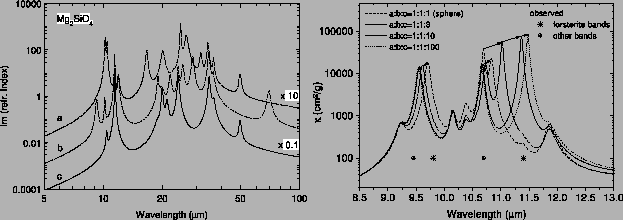


Next: Amorphous magnesium silicate
Up: Examples of data contained
Previous: Examples of data contained
Silicate minerals of the olivine and pyroxene classes
have been shown to be present in outflows of evolved
stars as well as in comets and protoplanetary disks.
The positions of the infrared emission bands
produced by these minerals are diagnostic for the
crystal structure as well as for the chemical composition,
especially the iron content. Comparison of the
laboratory data with observed features can constrain
the conditions in these environments which have led
to the formation or processing of the dust grains.
We have used the infrared optical constants of forsterite
contained in the database for calculating the absorption cross
sections of spherical and non-spherical particles in the
Rayleigh limit (see Fig. ![[*]](file:/usr/local/lib/latex2html/icons/crossref.gif) ). The spectra are
obtained by averaging the cross sections calculated for the
three different crystallographic directions. The spectra
show resonances due to surface modes which shift very
strongly in dependence on the aspect ratio of the particles.
This effect probably is very important for the identification
of emission features in astronomical spectra [7,8].
Interstellar polarization measurements and laboratory experiments
on the growth of silicate particles [9] support the
presence of elongated grains in astrophysical environments.
Information about the grain shape may provide constraints
for the formation mechanism of crystalline silicate grains,
i.e. the role of direct condensation vs. processing of previously
amorphous material.
). The spectra are
obtained by averaging the cross sections calculated for the
three different crystallographic directions. The spectra
show resonances due to surface modes which shift very
strongly in dependence on the aspect ratio of the particles.
This effect probably is very important for the identification
of emission features in astronomical spectra [7,8].
Interstellar polarization measurements and laboratory experiments
on the growth of silicate particles [9] support the
presence of elongated grains in astrophysical environments.
Information about the grain shape may provide constraints
for the formation mechanism of crystalline silicate grains,
i.e. the role of direct condensation vs. processing of previously
amorphous material.
Figure:
Left panel: Imaginary part of the refractive index for
crystalline forsterite (Mg SiO
SiO ) in the three different
crystallographic directions.
Right panel: Mass-normalized absorption cross section (MAC)
of prolate spheroidal forsterite particles (rotationally
averaged) with different axis ratios. The dots and asterisks
below the spectra indicate positions of astronomically
observed emission bands (after [6]).
) in the three different
crystallographic directions.
Right panel: Mass-normalized absorption cross section (MAC)
of prolate spheroidal forsterite particles (rotationally
averaged) with different axis ratios. The dots and asterisks
below the spectra indicate positions of astronomically
observed emission bands (after [6]).
 |



Next: Amorphous magnesium silicate
Up: Examples of data contained
Previous: Examples of data contained
root
2003-03-06

